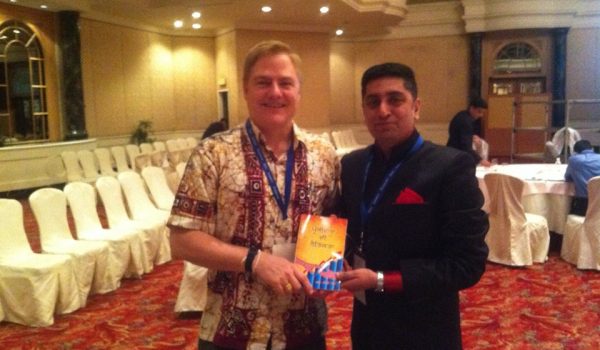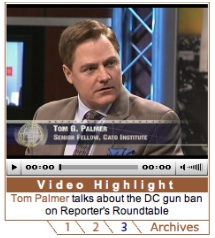Click here and then select the right video: “March 14, 2008: Tom Palmer talks about the DC gun ban on Reporter’s Roundtable”
My Discussion/Debate on the Second Amendment with Walter Dellinger
Post navigation
9 Responses to “My Discussion/Debate on the Second Amendment with Walter Dellinger”
Leave a Reply











Wow! I figured you’d win but I thought the other guy would at least put up a fight. His social science evidence is that cops say repealing the gun ban would be a bad thing? You’d flunk a first year stats class with that kind of “data.” Is there a source for the one claim he did make (that accidental shootings have gone down since the ban)?
It’s also comforting to know that whether a gun or a phone is more effective against an intruder is an irrelevant question since the District has already made that decision.
They’d better have stronger arguments in court or the justices might fine them for wasting everyone’s time.
I’d bet the farm on accidental shootings declining since the ban. A positive outcome of the ban to be sure but hardly a sufficient reason to uphold it. Data, to say nothing of principle, is definitely on the case of the prosecution.
Hope the Constitution prevails. Big case. . . . Good luck Tom!
I don’t have the time here, as I am under the gun for some presentations, but the data on murder (the majority of deaths from firearms in the District) are unequivocal. The murder rate went up after the ban and in the subsequent 30 years the murder rate has fallen to what it was before the ban in only one year. In 1993, 17 years after residents were forbidden from defending themselves in their homes with firearms, violent crime was 97% higher than in the year that the ban was imposed.
For data, consult the 2004 National Academies of Sciences study, “Firearms and Violence: A Critical Review,” Charles F. Wellford, John V. Pepper, and Carol V.
Petrie, Editors. The NAS reviewed 253 journal articles, 99 books, and 43 govt publications evaluating 80 gun-control measures. The researchers could not identify even one gun-control regulation that had reduced violent crime, suicide, or accidents.
If handguns become legal in the District after this summer’s ruling, it seems that at the very least, handgun ownership will remain at a level equal to the level it was at during the ban. Moreover, it would seem that more people would own a handgun once they’ve been made legal rather than more people getting rid of their handguns once they’ve been made legal.
Assuming more people aquire a handgun once the ban is lifted, unless there is a 0.00000… chance that a handgun accident will occur in the home (or anywhere else a handgun ends up) among people who now own a handgun once legalized who otherwise would not own a handgun while banned, all else being equal among those who previously owned handguns during the ban, doesn’t it follow that accidents would go up?
Maybe all else is NOT equal. Gun safety classes might be more prevalent in the D.C. area after the ban. Parents openly discuss gun safety with children where they otherwise might not have. The safety measures on handguns might be more widespread. Criminals now less to engage in activity with their handguns now they know would-be victims could own handguns.
What do you thing or know of that makes up for the increase in handgun accidents that occur in homes that would otherwise not had occured if a ban had been in effect? Thanks.
Maybe I would lose the farm on this one =)
You assume that no one in possession of an illegal handgun has an accident. The “more legal guns = more accidents” claim would need more evidence than merely saying “more legal guns = more accidents.”
You were very good in this debate.
Samuel, I did not make the assumption that people in possession of illegal handguns had no accidents. Had I though, it would be irrelevant. My point was that whatever the number of accidents that those people have- be it 5 or 5,000- by adding to the number of handgun owners, the absolute number of accidents will increase.
If p is the percentage of accidents occuring in the home of gun owners who disobey the gun law, p1 is the percentage of accidents occuring in the home of gun owners who obeyed the gun law, x is the number of gun owners who own a gun regardless of any law and y is the number of gun owners who own a gun only when made legal, the following is true is p is held constant:
p(x)<p(x)+p1(y)
If were as simple as that, that would be that. Social science is never that neat though so I’m curious as to what other variables should have been included in the previous equation to show that gun accidents decrease in the absence of gun control.
By lifting a gun ban, you will increase gun ownership given a large enough sample. If there are no other factors to include, it follows that gun accidents will go up since guns carry a risk, whatever percentage of risk that may be.
Is ‘p’ no longer constant because of something? What additional factors should be included in that equation? Given no other factors, gun accidents increase when gun ownership increases- plain and simple. If the N.A.S. study is right about seeing a decrease in gun accidents, what can we (or did the researchers) attribute that to?
I agree that “more guns=more accidents” claim is insufficient by itself and needs data to support it. What I’m suprised about is the N.A.S. study supporting the claim gun-control does not increase accidental gun injury.
Upon looking at the study for about 30 minutes, I could not find much of anything on accidental firearm injury. Didn’t seem conclusive either way on the topic of accidental injury but perhaps I missed something. http://www.nap.edu/catalog.php?record_id=10881
Samuel, I did not make the assumption that people in possession of illegal handguns had no accidents. Had I though, it would be irrelevant. My point was that whatever the number of accidents that those people have- be it 5 or 5,000- by adding to the number of handgun owners, the absolute number of accidents will increase.
If p is the percentage of accidents occuring in the home of gun owners who disobey the gun law, p1 is the percentage of accidents occuring in the home of gun owners who obeyed the gun law, x is the number of gun owners who own a gun regardless of any law and y is the number of gun owners who own a gun only when made legal, the following is true is p is held constant:
p(x)<p(x)+p1(y)
If were as simple as that, that would be that. Social science is never that neat though so I’m curious as to what other variables should have been included in the previous equation to show that gun accidents decrease in the absence of gun control.
By lifting a gun ban, you will increase gun ownership given a large enough sample. If there are no other factors to include, it follows that gun accidents will go up since guns carry a risk, whatever percentage of risk that may be.
Is ‘p’ no longer constant because of something? What additional factors should be included in that equation? Given no other factors, gun accidents increase when gun ownership increases- plain and simple. If the N.A.S. study is right about seeing a decrease in gun accidents, what can we (or did the researchers) attribute that to?
I agree that “more guns=more accidents” claim is insufficient by itself and needs data to support it. What I’m suprised about is the N.A.S. study supporting the claim gun-control does not increase accidental gun injury.
Upon looking at the study for about 30 minutes, I could not find much of anything on accidental firearm injury. Didn’t seem conclusive either way on the topic of accidental injury but perhaps I missed something. http://www.nap.edu/catalog.php?record_id=10881
Tom, way to duke it out! Just about every libertarian could learn how to better handle public speaking by watching this video. There were times when I wanted to interrupt the gov’t lawyer, and I bet you felt the same way, but you respectfully waited.
That the lawyer evaded your last, reasonable question should be revealing to anyone who watched.
Great stuff. Good luck in your fight for the Constitution.